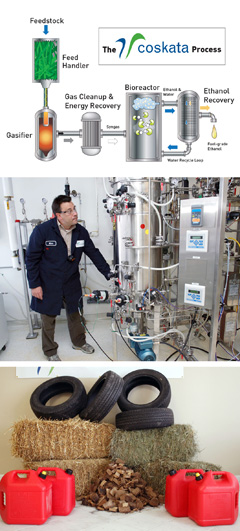News - HoldenUS ethanol innovator pushes for $300m Oz plantPlants to plant: Coskata has developed a unique biofermentation process to produce ethanol fuel. States vie to establish our first clean ethanol production plant as Holden goes E8530 Mar 2009 STATE governments are this week holding talks with one of the world’s leading ethanol promoters aimed at raising capital to build a major eco-friendly production plant here, estimated to cost about $300 million. Ethanol compatibility is one of the key planks of Holden’s plan to keep the Commodore large car, which remains the top-selling vehicle in Australia, viable over the next decade or more. American Wes Bolsen, the chief marketing officer government affairs for Coskata – a company with close links to General Motors – said commercial scale production was scheduled to begin at a plant in the US in 2012. Coskata claims to have a unique micro-organism that turns waste material, from plant fibre to old tyres, into almost pure ethanol. It is offering licences to potential development partners, including agricultural producers and even oil companies wanting to grab a share of a market estimated at up to $400 billion. Mr Bolsen said the Victorian government had been “very aggressive” through its investment promotion agency (Invest Victoria), but he will also have talks with the Queensland and NSW governments about building an ethanol plant. He then is planning to fly to Bangkok on Thursday for talks with the Thai government. He said Europe was not high on his list of priorities “because I don’t see the vision that Australia has today”. “Victoria has been very aggressive in trying to help us,” Mr Bolden told a media briefing this week. “The Invest Victoria team – and the GM team – have been very helpful in pulling together potential investors, feedstock suppliers and looking at locations which would work within the state of Victoria to do this. “Of course, I’m going to have discussions with Queensland and the New South Wales teams as well.”  Left: The secret to the Coskata process are micro-organisms in the bioreactor that eat carbon monoxide and hydrogen from the gasified feedstock, leaving 99.7 per cent pure ethanol. Left: The secret to the Coskata process are micro-organisms in the bioreactor that eat carbon monoxide and hydrogen from the gasified feedstock, leaving 99.7 per cent pure ethanol.Despite a global commitment by GM to ethanol – and, of course, other petrol-saving technologies – even Holden is concerned that Australian consumers will not get serious about the issues until petrol prices increase dramatically again and reaches $2 a litre. GM Holden’s recently appointed energy and environmental director Richard Marshall said the market only trended down to small cars when petrol previously peaked at around $1.70 per litre. In the meantime, Holden remains committed to making flex-fuel Commodores able to run on E85 (85 per cent ethanol and 15 per cent petrol) available from 2010, but there is still no mention of how the company will convince fleets to adopt the more environmentally friendly fuel. Speaking to GoAuto earlier this month, Holden managing director Mark Reuss described ethanol as the next frontier in the diversity of fuels, and indicated a desire to win over large commercial and government fleets to the E85 Commodore, which he said was still on target. “I don’t want to say there are any deals cut because there isn’t, but this is all about the opportunity and creating the opportunity and that’s what we’re doing,” Mr Reuss said. “Holden is going to be in a leadership position here with ethanol because we believe in it and we’re going to help drive some of the decisions around the infrastructure and the ability to adapt some percentage of fuel to ethanol.” Asked if the lack of infrastructure was an impediment to the widespread use of ethanol – there are only a handful of E85 pumps around the country, though E10 is widely available – Mr Reuss said: “I think there’s a really good way that we could do this, that would be a really good fleet-like application of E85, that would be a very viable distribution pattern as well in the country, so we’re looking at how we could do that.” In terms of alternative fuels, Mr Marshall said that LPG (liquefied petroleum gas) and CNG (compressed natural gas) had strong potential in Australia because of an abundance of gas, but that E85 still had “the greatest potential to displace significant amounts of petrol in the short-term”. He described ethanol made from food crops (such as sugar-based fuel produced in Queensland) as first-generation, while second-generation ethanol using plant waste and even landfill, as produced by Coskata – with a Biothermal production system that uses little water or energy – was now a commercial reality. However, Mr Marshall said that much work needed to be done on E85 infrastructure and availability in Australia, while the biggest and most difficult challenge was consumer acceptance and purchase. “There is no single solution to the problem of sustainable transport and at Holden we’re taking a multi-path approach, but E85 ethanol is a very significant part of our strategy, and very important for our future success,” said Mr Marshall. Coskata claims to have developed a unique process to produce commercial quantities of ‘feedstock flexible ethanol’ and is building a ‘semi-scale’ plant in Pennsylvania to prove its large-scale viability to potential investors. Mr Bolsen said commercial-scale production would begin in a south-east US state in 2012, producing up to 250 million litres of ethanol a year, and is also looking at a facility in Florida with a capacity of 400 million litres a year. He admits the global economic downturn has seriously affected investment, but still plans rapid expansion, saying he would like to see the construction of as many as 50 new plants a year. Even oil companies were now coming to the realisation that large-scale ethanol production was inevitable, he said, because it was now so hard to find new oil reserves. “We are seeing a wholly different attitude and approach (from the oil companies),” said Mr Bolsen. “Coskata has been in discussions with most of the major global oil companies. They see this is inevitable, it is here and it will compete head-to-head.” Mr Bolsen said he expected his trip to Australia to be “very beneficial” as there was a lot of interest here for the technology, but agreed that finance would be hard to find and required government assistance. “Financial markets are closed globally. Even when you have a return as high as you have today, lending is not available. “It is the role of government to help bridge the gap of getting first-of-kind technology deployed, so what we’re looking at in Australia is a true partnership coming together between government, auto-maker, flexible technology and the ability to bring in the required feedstock.” Mr Bolsen said Coskata was ready to deploy its technology and was only being delayed by the global financial crisis, adding there was no time to wait for banks to look at a full-scale plant operating fully before committing capital. “We don’t have time to wait the two and a half years it takes to build a facility and then have Australia start thinking about it – we need to deploy the technology now. “Give me the chance to build one plant in Australia and there will not be a financial problem. Give an Australian company the chance to deploy the Coskata technology and that will hopefully be the only assistance that is needed because then the banks will see (it working) and greed does set in. “Someone who can see a 20-30 per cent return on a facility will finance every project you ever need. But you have to get the first one built and you need that deployment to happen relatively quickly.” Do not, however, expect GM to jump in and become a fuel producer because both the US parent and its local subsidiary have made it clear they only want to build cars, not refineries. Read more:Ethanol Holdens a year awayGM invests in ethanol |
Click to shareHolden articlesResearch Holden Motor industry news |














Facebook Twitter Instagram